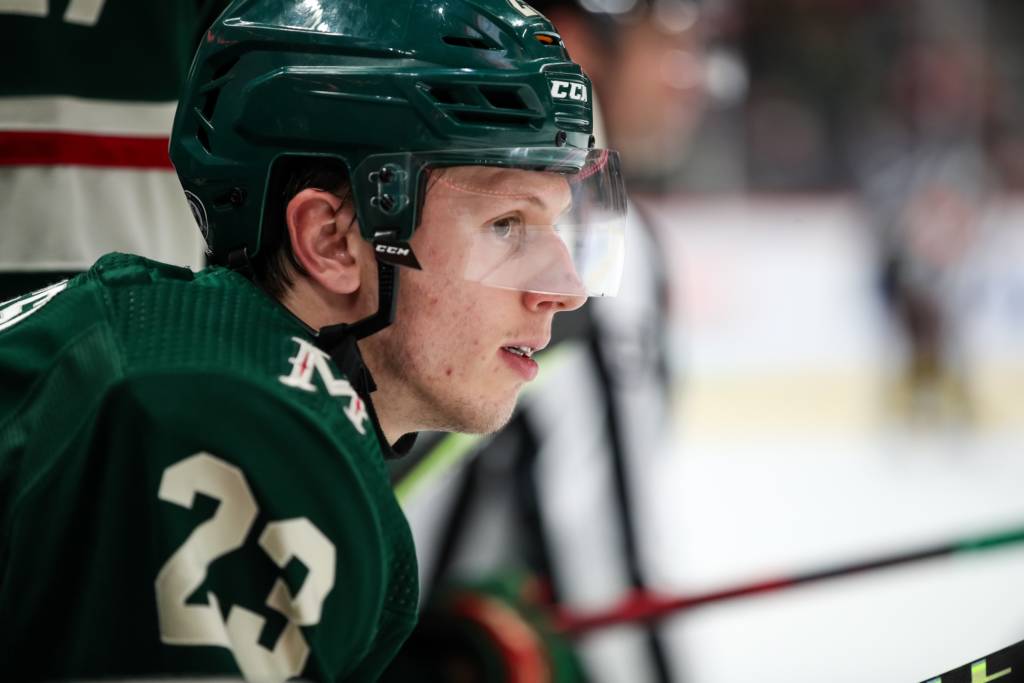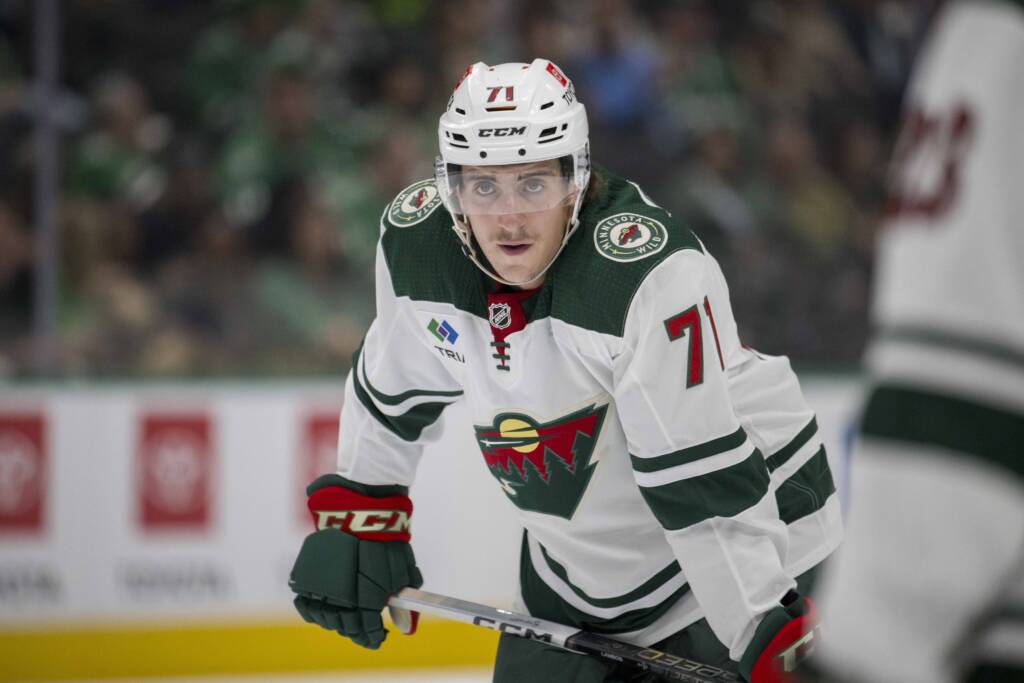Monday’s deadline for submitting opening night rosters is fast approaching. Minnesota Wild fans will finally get to see who will win the roster battles that have happened throughout training camp. With big-name prospects like Marco Rossi, Matt Boldy, and Adam Beckman duking it out, it’s been an exciting race.
We don’t know for sure, yet, but it’s possible that competition among prospects may wind up more theatrical than real. On Tuesday, the Wild claimed Rem Pitlick, a 24-year-old Nashville Predators farmhand with 28 goals and 46 points in 71 AHL games. Minnesota’s made it clear they’re keeping him on the roster The Athletic’s Michael Russo reports Iowa Wild bottom-sixer Brandon Duhaime is the favorite to claim the final roster spot.
The unspoken third winner is Greyhound Buses to Des Moines. If those predictions hold, and there are no surprise trades or cuts, Rossi, Boldy, and Beckman will start in Iowa. The question then becomes: When will they make their debuts in St. Paul?
It’s a particularly interesting question for Rossi. Given that he missed essentially 18 months of hockey between the coronavirus pandemic and his own medical issues stemming from an infection, it’s not surprising that he’d start in Iowa. That fate was expected until he made noise in the Olympic Qualifiers and at Minnesota’s prospect camp.
Rossi would’ve had to prove he was unquestionably ready for the NHL to make the team out of camp. Did he? It depends on the lens you look through. He contributed zero points and three shots on goal (on six attempts) in 39 5-on-5 minutes. Granted, three of his chances were high-danger, but he wasn’t a shot machine like Beckman.
When you look at the offense generated with Rossi on the ice, though, he was one of Minnesota’s best centers. The Wild controlled 58% of expected goals when Rossi played at 5-on-5, ahead of every center candidate but Joel Eriksson Ek and Victor Rask. He jump-started the Wild’s offense in particular, as they racked up 30.2 scoring chances per hour with Rossi. Mats Zuccarello was the only forward to get more.
So, could Rossi have been in the lineup opening night? There’s a case for it. But if Beckman couldn’t crack the roster with a four-goal-in-four-game performance, there was no way Rossi was staying off I-35.
It’s surely disappointing, given all the work Rossi put into his comeback, but he should flourish in Iowa. Assuming health (no guarantee after Boldy and Calen Addison left Thursday’s game with injury), the Baby Wild should have a ton of young talent for Rossi to play with.
In addition to Boldy, Beckman, and Addison, Connor Dewar, Will Bitten, and Mason Shaw are coming off productive AHL seasons. Newcomers Alex Khovanov and Nick Swaney could also push for an offensive role. If Rossi is there for a glorified rehab stint, there are worse places to be.
If Rossi returns to Minnesota in two or three months, no one should lose sleep over it. But what if the Wild don’t recall Rossi for the entire season? It might sound absurd, but there’s a powerful salary cap-related incentive to do just that.
As Russo indicated in a story Tuesday night, Rossi’s age allows his Entry-Level Contract to “slide” to next season if he plays nine or fewer games this year. If he plays 10 games (including playoffs), it burns the first year of his ELC.
Starting Rossi’s restricted free agent clock next year heads off a potential headache for Minnesota. Since his ELC is three years, limiting him to nine or fewer games makes the difference between him becoming an RFA in Summer 2024 or 2025. Minnesota will carry nearly $15 million of buyout penalties in 2024, which drops to less than $2 million in 2025.
It’s a big difference, and should his ELC slide to next year, it leaves the Wild less vulnerable to a cap crunch and offer sheet potential, even if he commands a big raise.
So is it smart business for Minnesota to stash him in Des Moines all season?
No.
The Wild’s biggest upgrade at center was moving Eriksson Ek to his rightful place on the first line. That’ll help, especially with Kirill Kaprizov, but past that? They’ll once again try to make do with some combination of Ryan Hartman, Rask, Nick Bjugstad, Nico Sturm, and now Frederick Gaudreau and Pitlick.
It might work for them for a few months in the regular season, but it sure didn’t work against the Vegas Golden Knights. Rossi’s services will likely be needed to solidify Minnesota’s patchwork center situation.
And if they are, Minnesota shouldn’t worry about cap implications in 2024. This year may be their best shot at the Cup in the next four. Their buyout penalty is under $5 million this season, and will increase to almost $13 million for 2022-23. With Kevin Fiala due for a raise next season, this might be their final year with their secondary game-breaker.
Can Minnesota justify keeping Rossi’s powder dry when they might not have a better opportunity to win? To let Fiala leave without ever seeing his potential next to a player as skilled as Rossi? To burn off one of the precious five years of Kaprizov’s contract without taking their best swing?
It just doesn’t add up. This year is much more pressing than worrying about what might happen in 2024.
Another reason is this: Teams usually figure stuff out when it comes to getting RFAs to cap-compliant deals. The St. Louis Blues found themselves needing to sign Robert Thomas with under $1 million in cap space this summer. They flipped Zach Sanford, a fine but not crucial piece, for former first-rounder Logan Brown, clearing the $2 million necessary to ink Thomas.
The Tampa Bay Lightning and Vancouver Canucks have navigated much nastier cap situations. The Canucks needed to sign stars Elias Pettersson and Quinn Hughes this summer. Pettersson was thought to be in a position to command Kaprizov-type money. He got less than $8 million per year, as did Hughes. Tampa manages to get stars like Brayden Point, Anthony Cirelli, and Mikhail Sergachev to take steep discounts for cap purposes on an annual basis.
In an environment where offer sheets are rarely used, RFA situations tend to work themselves out. The Wild also have time to construct a plan to leave cap space open. Zuccarello has $6 million coming off the books in Summer 2024. Matt Dumba’s $6 million cap hit clears in 2023. If Minnesota wants to plan for Rossi’s next contract, they can start in two years instead of wasting this one.
When a player’s ready, they’re ready. Maybe Rossi needs two or three months in Iowa to prove he’s truly ready for NHL action. But there’s little chance he needs a full year of seasoning to reach his potential. Rossi is no ordinary prospect. He’s got an advanced game and racked up video game numbers in the OHL. He has an NHL body and a clean bill of health.
He can help Minnesota this year, when they have a legitimate shot in a weak Western Conference. Going into the playoffs without Rossi will noticeably hurt their chances, given their current center depth. The Wild may worry about affording Rossi’s next deal, but they can afford to punt this year for the sake of playing service time games even less.
All data from Natural Stat Trick unless otherwise indicated.

